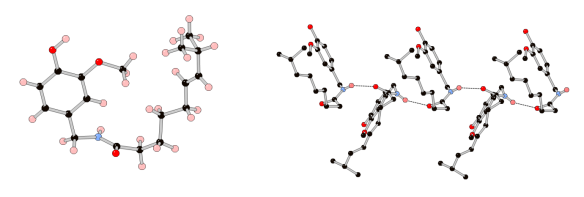Some Like It Hot – Capsaicin
What does it look like?

Image generated with Crystal Maker software http://www.crystalmaker.com/
What is it?
Capsaicin is the compound that puts the red hot in chili peppers. Around the world people have a fascination with spicy food and, despite the sweats, sensation of fire and cramps that make you want to get up and jump, people can't stop eating it. Personally, me and my friends, near midnight, will have one hot minute with a curry that will torture me and knock me down, leaving me a skinny, sweaty man lying under the bridge feeling like I have scar tissue inside.
The compound was first isolated in 1816, although has been around in various cuisines for much longer. Within chilies, the concentration of capsaicin is highest in the pith to which the seeds are attached. It is possible that the heat is a biological deterrent to prevent mammals from eating the seeds, as they digest them and prevent reproduction (of the chillies). Although capsaicin can be used as an analgesic to help make you feel better, dosed in low concentrations, it is better known as the active ingredient in pepper spray.
Currently the hottest known chilli, according to the Guinness Book of Records, is the Carolina Reaper – they're red hot. This is a hybrid species made by the appropriately named Puckerbutt Pepper Company and reaches 2.2 million on the Scoville scale which is no minor thing (for context, Habenero is only 350,000). I don't know how they give it away.
Where did the structure come from?
Data for this structure comes from a 1998 paper in Chemical Communications (David, Shankland and Shankland, Chem. Commun., 1998, 931). The paper is fascinating as it describes how crystal structures of organic compounds can be solved using X-ray powder diffraction, whereby the powder contains numerous microcrystals, rather than using single crystals which is the standard method. The presence of multiple crystallites gives overlapping data that can be hard to extract a structure from, and this challenge remains on-going in structural chemistry.
By the way – there is a theme running through this post. Find the theme and see how many references to it there are. No prizes, just for fun, but let us know if you get it.






